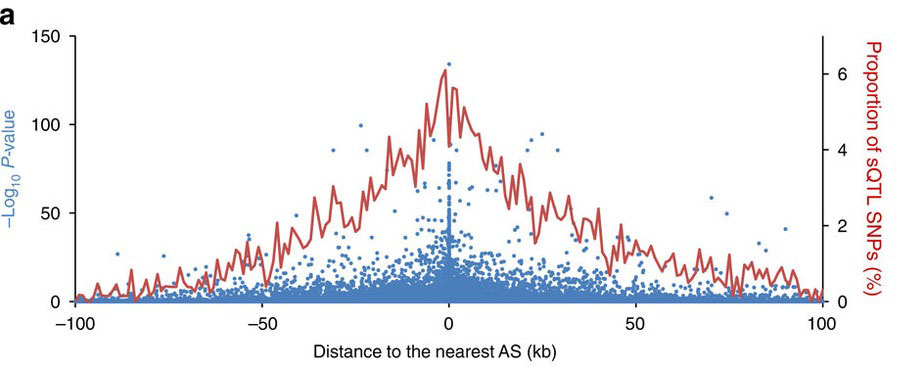ヒト脳でのスプライシングQTLのゲノムワイドな同定およびその統合失調症関連座位での豊富な存在
Genome-wide identification of splicing QTLs in the human brain and their enrichment among schizophrenia-associated loci
2017年2月27日 Nature Communications 8 : 14519 doi: 10.1038/ncomms14519

トランスクリプトームの詳細な解析から選択的スプライシング(AS)の調節の複雑性が明らかになっている。これらのAS事象は遺伝的バリアントによる調節を受けることが多い。 本論文では、206人の前頭前皮質のRNA塩基配列解読データを、遺伝型と組み合わせて解析し、ゲノム全体にわたってシスに作用するスプライシング量的形質座位(sQTL)を突き止めた。これらのsQTLは、エキソンやH3K4me3に標識される領域に豊富に存在していた。そのうえ、sQTLは、GWASによって同定された疾患関連座位、特に、統合失調症のリスク座位に有意に豊富に観察された。統合失調症関連座位をそれぞれ詳細に調べると、4つの領域(NEK4、FXR1、SNAP91あるいはAPOPT1を含む領域)で、GWASのインデックスSNPが1つあるいは複数のsQTL SNPと強力な連鎖不平衡にあることが明らかになったことから、これらの領域の関連シグナルの原因となる機構がASの調節異常であると示唆された。我々の研究は、ヒト脳におけるsQTL SNPの有益な情報リソースとなり、また、それを用いて、統合失調症などの複雑な脳疾患の遺伝的構造の理解を促すことができることを示している。
Corresponding Authors
Detailed analyses of transcriptome have revealed complexity in regulation of alternative splicing (AS). These AS events often undergo modulation by genetic variants. Here we analyse RNA-sequencing data of prefrontal cortex from 206 individuals in combination with their genotypes and identify cis-acting splicing quantitative trait loci (sQTLs) throughout the genome. These sQTLs are enriched among exonic and H3K4me3-marked regions. Moreover, we observe significant enrichment of sQTLs among disease-associated loci identified by GWAS, especially in schizophrenia risk loci. Closer examination of each schizophrenia-associated loci revealed four regions (each encompasses NEK4, FXR1, SNAP91 or APOPT1), where the index SNP in GWAS is in strong linkage disequilibrium with sQTL SNP(s), suggesting dysregulation of AS as the underlying mechanism of the association signal. Our study provides an informative resource of sQTL SNPs in the human brain, which can facilitate understanding of the genetic architecture of complex brain disorders such as schizophrenia.

